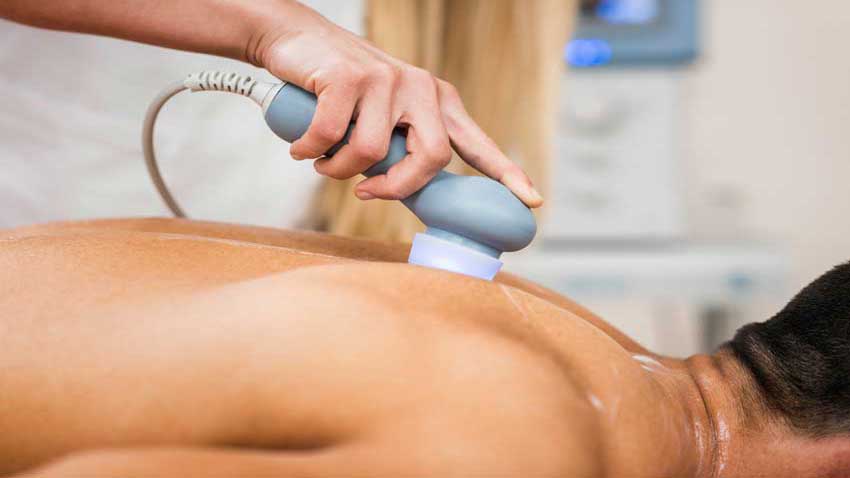
Physio Medicine Treatments
Physio medicine modalities can assist the healing process, decreases pain and discomfort from injuries, and can help strengthen, relax, and heal muscles and soft tissues.
Below are a few of the treatment modalities we use daily at Ahnen Chiropractic.
Hot Packs:
We wrap moist hot packs in several layers of towels and place them on the area that needs treatment. The heat provided by the hot packs has several important benefits. It relaxes tight muscles, causing tissues to relax. This decreases pain caused by muscle tension or spasms. It also causes vasodilation of the blood vessels which increases circulation to the area. Patients with muscle strains, spasms, or arthritis often benefit from treatment with moist hot packs.
Cold Packs:
Cold Packs are a frozen gel substance used by to treat areas of pain and inflammation. The cold packs are wrapped in a paper towel and applied directly to the area in need of treatment. The cold transferred to the patient’s skin, muscle, and tissue has several beneficial effects.
Electrical Muscle Stimulation:
An electrical current used to cause a single muscle or a group of muscles to contract.
By placing electrodes on the skin in various locations the we can recruit the appropriate muscle fibers. Contracting the muscle via electrical stimulation helps strengthen the affected muscle. The current settings can be changed to allow for a forceful or gentle muscle contraction. Along with increasing muscle strength, the contraction of the muscle also promotes blood supply to the area that assists in healing.
TENS:
A TENS unit stands for transcutaneous electrical nerve stimulation. It is a small battery operated machine that uses electrical transmission to decrease pain. Electrodes are applied to the affected area. The machine is turned on and an electrical current is sent through the electrodes. A tingling sensation is felt in the underlying skin and muscle. This signal disrupts the pain signal that is being sent from the affected area to the surrounding nerves. By breaking this signal, the patient experiences less pain. These units may be used at home.
Interferential Current: Interferential Current Therapy (IFC)
Patient Benefits:
- Reduces painful symptoms
- Decreases local swelling
- Helps restore normal movements
- Releases the body’s natural painkillers
- Accelerates the healing process
Interferential current therapy is a treatment to aid the relief of pain and the promotion of soft-tissue healing.
Tiny electrical impulses are induced into the tissues in the area of the pain. Where these waves intersect below the surface of the skin, the low-frequency stimulation induces the body to secrete endorphins, which are the body’s natural pain-killers.
Most patients find interferential therapy to be very beneficial and describe the treatment as being relaxing and having a ‘pins and needles’ sensation.
Ligament sprains, muscle strains and spasms often respond well to interferential current therapy
Micro current: Micro current Therapy
For patients with chronic pain, micro current therapy can be a godsend. Its track record is particularly good for conditions such as fibromyalgia, neuropathy, shingles, sciatica, diabetic ulcers, and other intractable conditions that often fail to respond to conventional treatment.
- Arthritis
- Back pain
- Diabetic ulcers
- Fibromyalgia
- Headaches
- Herpes
- Neuropathy
- Sciatica
- Shingles
- Slow-healing wounds
- Sports injuries
- Tendon and ligament pain
Laser:
Cold Laser / Low Level Laser Therapy (LLLT) for tissue healing, inflammation, pain relief and wounds.
Low Level Laser Therapy (LLLT) or “cold laser therapy” is on track to become one of the most important developments in life sciences since the discovery of penicillin. LLLT dramatically reduces musculoskeletal pain and inflammation as well as promoting tissue repair wherever the laser beam is applied. This is not a heat treatment, the effects are photochemical. One of the primary actions is on mitochondrial production of ATP, therefore potentially affecting any eukaryotic cell in the body.
LLLT has undergone over 1000 published laboratory studies and is already proven in over 100 successful randomised double blind controlled clinical trials (RCT’s). These trials include osteoarthritis, tendinitis / tendinopathies and other sports injuries, back and neck pain, diabetic foot and venous ulcer wound healing.
Hot wax
Pneumatic Therapy – air pressure used to apply pressure.
Inter-segmental traction:
Patient Benefits:
- Reduces painful symptoms
- Increases spinal mobility
- Improves blood supply to the disc, causing it to heal more quickly
- Decreases local swelling
- Reduces spinal fixations
- Accelerates the healing process
- Combined with the Chiropractic Adjustment, Inter-segmental Traction is a very effective way to help your body heal more quickly






